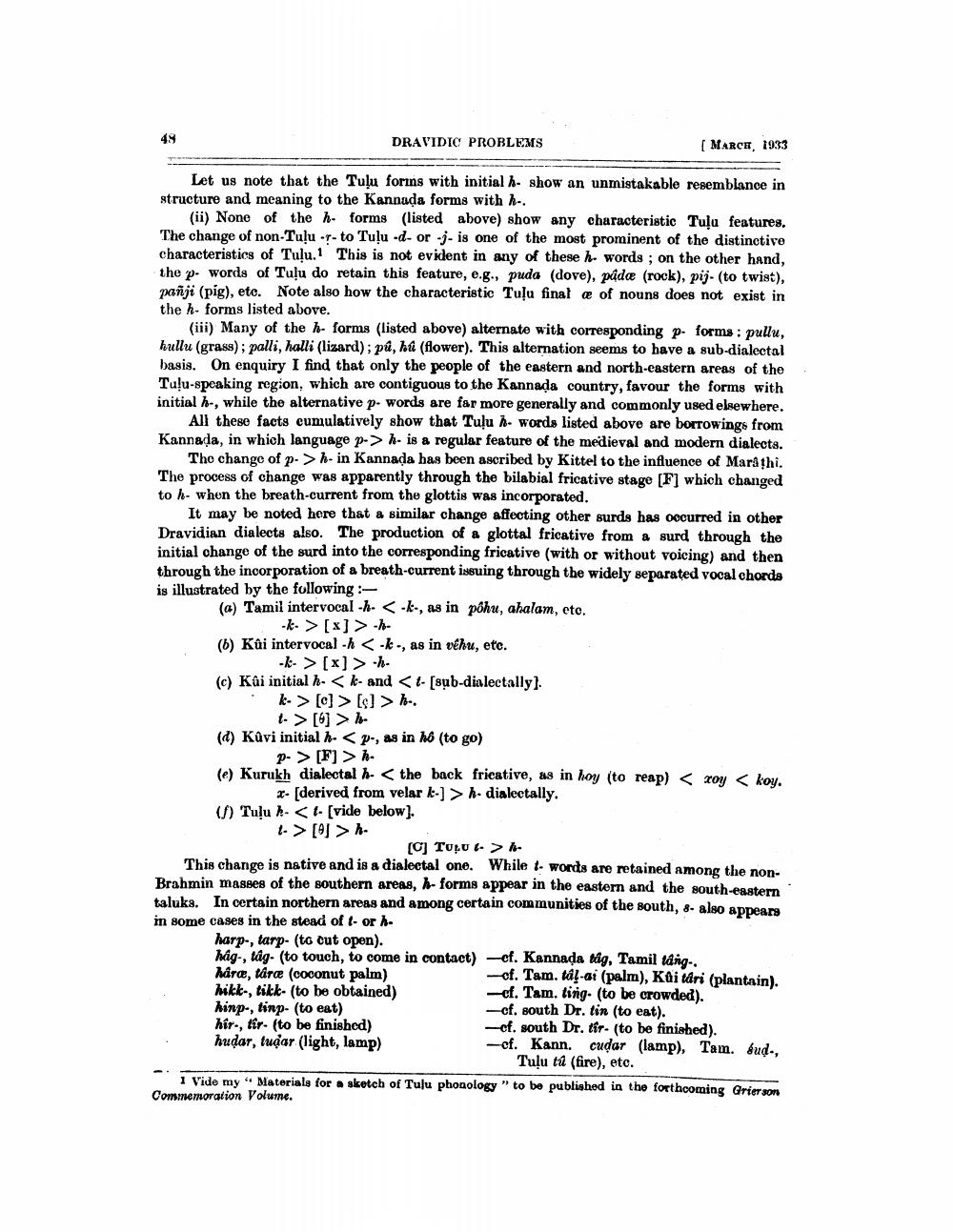________________
DRAVIDIC PROBLEMS
[ MARCH, 1933
Let us note that the Tulu forins with initial h- show an unmistakable resemblance in structure and meaning to the Kannada forms with h..
(ii) None of the h- forms (listed above) show any characteristic Tulu features. The change of non-Tulu -?- to Tulu -d- or -j- is one of the most prominent of the distinctive characteristics of Tulu. This is not evident in any of these h- words ; on the other hand, the p- words of Tuļu do retain this feature, e.g., puda (dove), pádæ (rock), pij. (to twist), panji (pig), etc. Note also how the characteristic Tuļu final æ of nouns does not exist in the h- forms listed above.
(iii) Many of the h- forms (listed above) alternate with corresponding p. forms: pullu, hullu (grass); palli, halli (lizard); på, ha (flower). This alternation seems to have a sub-dialectal basis. On enquiry I find that only the people of the eastern and north-eastern areas of the Tuļu-speaking region, which are contiguous to the Kannada country, favour the forms with initial h-, while the alternative p- words are far more generally and commonly used elsewhere.
All these facts cumulatively show that Tuļu - words listed above are borrowings from Kannada, in which language p->h- is a regular feature of the medieval and modern dialects.
The change of p->h-in Kannada has been ascribed by Kittel to the influence of Marathi. The process of change was apparently through the bilabial fricative stage [F] which changed to h- when the breath-current from the glottis was incorporated.
It may be noted here that a similar change affecting other surds has occurred in other Dravidian dialects also. The production of a glottal fricative from a surd through the initial change of the surd into the corresponding fricative (with or without voicing) and then through the incorporation of a breath-current issuing through the widely separated vocal chords is illustrated by the following: - (a) Tamil intervocal . <-k-, as in pôhu, ahalam, eto.
-k>[x]> -- (6) Kûi intervocal -h <-k., as in vehu, etc.
-k-> (x) > h. (c) Kûi initial h. <k- and < 1 [sub-dialectally!
k-> [e] > [s] > h.
t-> (6) > l(d) Kúvi initial h. <p-, as in hô (to go)
P-> [F] > h. (e) Kurukh dialectal h. < the back frieative, as in hoy (to reap) < xoy < koy.
[derived from velar -] > - dialectally. Tulu - < t- [vide below). 1->[9> h
(C) TULU -> hThis change is native and is a dialectal one. While it- words are retained among the nonBrahmin masses of the southern areas, h- forms appear in the eastern and the south-eastern taluks. In certain northern areas and among certain communities of the south, 8. also appears in some cases in the stead of t- or h.
harp-, tarp- (to cut open). mag-, tág. (to touch, to come in contact) -ef. Kannada tág, Tamil lang.. háre, káræ (coconut palm)
-of. Tam. tal-ci (palm), Kai tari (plantain). hikk-, tikk- (to be obtained)
-cf. Tam. ting. (to be crowded). hinp-, tinp. (to eat)
-cf. south Dr. tin (to eat). hir., tir. (to be finished)
-of. south Dr. tir. (to be finished). hudar, tudar (light, lamp)
-of. Kann. cudar (lamp), Tam. bud.,
Tuļu ta (fire), etc. i Vide my " Materials for a sketch of Tulu phonology" to be published in the forthcoming Grierson Commemoration Volume.




